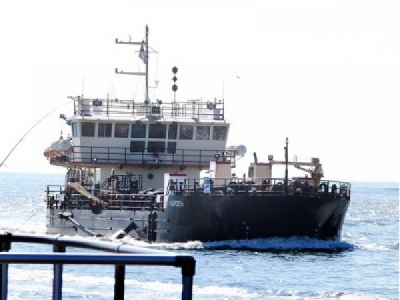
Posted on May 1, 2018
By Dinah Voyles Pulver, News-Journal
Captain Michael Mulholland was a man on a mission earlier this year, working to bring attention to dangerous shoaling sand conditions in Ponce Inlet.
Mulholland, who operates Sea Spirit Deep Sea Fishing and the Manatee Scenic Tour Boat, called and wrote local and federal officials, saying shoaling in the inlet had reached a critical point. Hurricane Irma and continued nor’easter conditions offshore last fall had pushed significant amounts of sand into the inlet.
The huge volumes of sand made it “nearly impossible and very difficult for boaters to navigate both in and out of the inlet, especially on half to low tide,” Mulholland said. Ultimately the U.S. Army Corps of Engineers agreed and brought in one of its hopper dredges to conduct an emergency dredging project.
The Dredge Murden arrived in early April and finished its work on Friday, said Corps spokeswoman Susan Jackson. The Corps and the U.S. Coast Guard had received reports of extreme shoaling and groundings in two areas, Jackson said.
The dredge and its crew worked to create a channel that would allow for safe navigation until a full-fledged, previously scheduled, dredging project begins this summer.
The Murden removed about 17,000 cubic yards of sediment and placed it near-shore for natural progression onto New Smyrna Beach where it will help reduce risk to upland infrastructure, Jackson said. The 156-foot dredge sucks up the sand and then moves out of the inlet and drops the dredged sand offshore. It can haul up to 512 cubic yards of material at a time.
Now the Murden is moving to the Intracoastal Waterway for a week for emergency work to remove another 7,000-10,000 cubic yards of sand, she said.
The work is being paid for through the Corps’ Jacksonville district’s operations and maintenance funds, Jackson said. The near-shore placement work is a regional sediment management project rather than a federal shore project, she said, a way to maximize the benefits of the Corps’ work to maintain channels and safe navigation.
“It not only provides risk reduction, environmental benefits and keeps the sand in the natural system, it also saves federal taxpayers the cost of placing sediment off-shore or upland,” she said. “It’s a win-win best practice whenever channel sediment meets the state beach sand standard.”
In Florida, the Corps works with the Florida Department of Environmental Protection to combine the placement opportunities with the state’s coastal management plan, Jackson said. Dredging the sand from inlets and placing it in the near shore environment for gradual migration to the beach saved an estimated $100 million in Florida, Georgia and the Carolinas in 2016.
For Mulholland, it has been rewarding to see the dredge arrive and begin pulling the sand out of the inlet.
“I’m glad my voice was heard,” he said this week. “I was very persistent, and being persistent very definitely paid off. It was a lot of work.”
“It was getting to the right people and a lot of letter writing,” he said. “And, it was kind of making a lot of noise.”
While Mulholland was calling and writing letters, another boat, the shrimp boat Calico Jack became stuck in the inlet during high tide, he said. In that case, “the captain kept maneuvering until he was able to back off the sandbar and get around it.”
He worked with Brandon Patty of St. Augustine, who was briefly in a race for Congress in 2016. “Brandon was a big help,” said Mulholland. “He’s the one who got Congressman (Ron) DeSantis’ office involved.”
They also worked with the local Coast Guard staff out of New Smyrna Beach.
“They helped us tremendously, moving the channel markers around so boaters could have a safe passage,” he said. “We definitely owe the New Smyrna Beach Coast Guard thanks for their efforts.”
The project had to wait for the Murden to finish other jobs, but it was worth the wait, Mulholland said.
“It’s made a big difference already,” he said. “It has helped us a lot. Thank God.”
The dredging project this summer will be the largest inlet channel maintenance dredging effort in Ponce Inlet since 2008, according to Volusia County officials. That dredging will be designed to provide long-term relief for deeper vessels that use the inlet.
“This summer’s contract is robust. Work will clear all the federal channel in the area to authorized depths, removing about 400,000 to 500,000 cubic yards in total, and placing it in the near-shore area,” Jackson said. “Sediment reuse provides opportunities for natural flood protection and wider beaches for shorebird and sea turtle nesting, as well as recreational opportunities.”
Source: The Daytona Beach News-Journal





